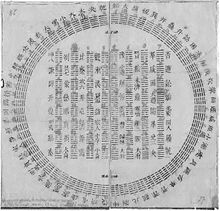This is an old revision of this page, as edited by Netherzone (talk | contribs) at 16:59, 27 February 2024 (Undid revision 1210548719 by 208.223.66.147 (talk) not an improvement, it was clearer before this change). The present address (URL) is a permanent link to this revision, which may differ significantly from the current revision.
Revision as of 16:59, 27 February 2024 by Netherzone (talk | contribs) (Undid revision 1210548719 by 208.223.66.147 (talk) not an improvement, it was clearer before this change)(diff) ← Previous revision | Latest revision (diff) | Newer revision → (diff) Six stacked horizontal lines used in Chinese divination
The I Ching book consists of 64 hexagrams. A hexagram in this context is a figure composed of six stacked horizontal lines (爻 yáo), where each line is either Yang (an unbroken, or solid line), or Yin (broken, an open line with a gap in the center). The hexagram lines are traditionally counted from the bottom up, so the lowest line is considered line one while the top line is line six. Hexagrams are formed by combining the original eight trigrams in different combinations. Each hexagram is accompanied with a description, often cryptic, akin to parables. Each line in every hexagram is also given a similar description.
The Chinese word for a hexagram is 卦 "guà", although that also means trigram.
Types
| This article needs additional citations for verification. Please help improve this article by adding citations to reliable sources. Unsourced material may be challenged and removed. Find sources: "Hexagram" I Ching – news · newspapers · books · scholar · JSTOR (July 2021) (Learn how and when to remove this message) |

Classic and modern I Ching commentaries mention a number of different hexagram types:
- Eight Trigrams
- Original Hexagram
- Future Hexagram
- Contrasting (Reverse) Hexagram (is found by turning a hexagram upside down)
- Complementary Hexagram (is found by changing all the lines into their opposite)
- Hexagram of Sequence
- Nuclear (Mutual) Hexagram (hu gua) (is found by taking the inner lines of a hexagram; given that the original hexagram's lines are labeled 1 through 6 from bottom up, the nuclear hexagram contains the lines 2, 3, 4, 3, 4, 5)
- Hexagram of Change (bian gua)
- Internal Hexagram (nei gua)
- External Hexagram (wai gua)
Sequences
The most commonly known sequence is the King Wen sequence. A totally different sequence was found in the Mawangdui Silk Texts. The hexagrams are also found in the Binary sequence, also known as Fu Xi sequence or Shao Yong sequence.
Lookup table
See also
References
- Perkins, Franklin. Leibniz and China: A Commerce of Light. Cambridge: Cambridge University Press, 2004. p 117. Print.
- Wilhelm, Richard (1950). The I Ching or Book of Changes.
- Legge, James (1964). I Ching: Book of Changes.
- ^ "Hexagrams of context". I Ching with Clarity.